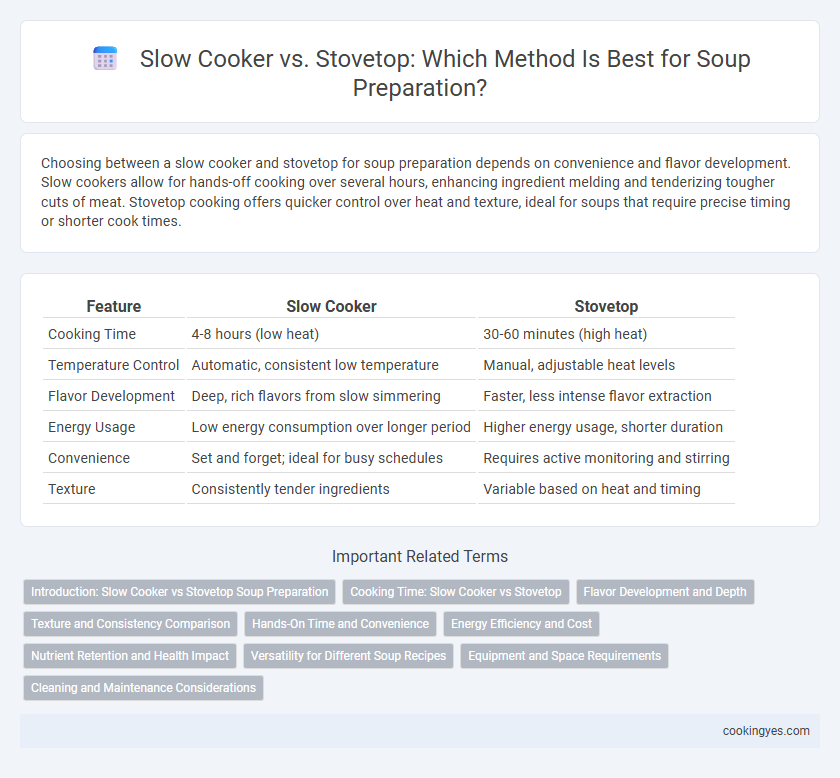Choosing between a slow cooker and stovetop for soup preparation depends on convenience and flavor development. Slow cookers allow for hands-off cooking over several hours, enhancing ingredient melding and tenderizing tougher cuts of meat. Stovetop cooking offers quicker control over heat and texture, ideal for soups that require precise timing or shorter cook times.
Table of Comparison
| Feature | Slow Cooker | Stovetop |
|---|---|---|
| Cooking Time | 4-8 hours (low heat) | 30-60 minutes (high heat) |
| Temperature Control | Automatic, consistent low temperature | Manual, adjustable heat levels |
| Flavor Development | Deep, rich flavors from slow simmering | Faster, less intense flavor extraction |
| Energy Usage | Low energy consumption over longer period | Higher energy usage, shorter duration |
| Convenience | Set and forget; ideal for busy schedules | Requires active monitoring and stirring |
| Texture | Consistently tender ingredients | Variable based on heat and timing |
Introduction: Slow Cooker vs Stovetop Soup Preparation
Slow cookers provide a convenient, hands-off approach to soup preparation by maintaining consistent low temperatures for hours, which enhances flavor development and tenderizes ingredients effectively. Stovetop methods offer precise temperature control and faster cooking times, allowing for quick adjustments to texture and seasoning during the process. Choosing between the two depends on desired cooking duration, texture preference, and available kitchen equipment.
Cooking Time: Slow Cooker vs Stovetop
Slow cookers typically require 6 to 8 hours on low heat to achieve deeply flavored soups, while stovetop cooking can prepare soup in as little as 30 to 45 minutes. The slow cooking process allows ingredients to meld gradually, enhancing texture and taste, whereas stovetop methods offer faster results with more immediate heat control. Choosing between the two depends on available time and desired depth of flavor in the soup.
Flavor Development and Depth
Slow cooker soup preparation allows flavors to meld gradually over several hours, enhancing depth and complexity through prolonged simmering at low temperatures. Stovetop cooking provides quicker heat control, often yielding brighter, more distinct ingredient flavors but may lack the layered richness achieved in slow cooking. For deepest flavor development, slow cooking maximizes infusion of spices, herbs, and aromatics, while stovetop methods excel in preserving fresh taste nuances.
Texture and Consistency Comparison
Slow cooker soup preparation results in a tender, well-blended texture as low, consistent heat allows ingredients to break down gradually, enhancing flavor integration and yielding a thicker, heartier consistency. Stovetop cooking offers more control over texture with adjustable heat settings, enabling quicker cooking times and the ability to achieve a variety of consistencies, from chunky to smooth. The choice between slow cooker and stovetop methods directly influences the final soup's mouthfeel and thickness, depending on cooking duration and temperature control.
Hands-On Time and Convenience
Slow cookers require minimal hands-on time, allowing soup to simmer unattended for hours, making them ideal for busy schedules and convenience-focused cooking. Stovetop methods demand more active monitoring and stirring to prevent burning or boiling over, increasing hands-on involvement. Slow cookers offer consistent temperature control and automatic shut-off features, enhancing convenience compared to the stovetop's manual adjustments.
Energy Efficiency and Cost
Slow cookers consume significantly less energy than stovetop methods, often using about 70-80% less electricity due to lower heat settings and prolonged cooking times. Stovetop cooking rapidly heats and requires constant monitoring, which can increase gas or electric stove energy consumption and overall cost. Investing in a slow cooker reduces utility bills and offers consistent energy-efficient soup preparation suitable for budget-conscious households.
Nutrient Retention and Health Impact
Slow cookers maintain more nutrients in soups by cooking at lower temperatures over extended periods, preserving vitamins like C and B complex that are sensitive to heat. Stovetop methods use higher temperatures and shorter cooking times, which can cause nutrient loss but often provide faster preparation. Slow cooking also enhances the absorption of antioxidants and phytochemicals, promoting better health outcomes through soups rich in bioavailable nutrients.
Versatility for Different Soup Recipes
Slow cookers offer exceptional versatility for soup preparation by allowing low and slow cooking, which enhances flavors in broths, stews, and creamy soups without constant supervision. Stovetop methods provide greater control over temperature adjustments, ideal for recipes requiring quick simmering or precise ingredient incorporation. Choosing between slow cooker and stovetop depends on recipe complexity, desired texture, and time availability, with both methods supporting diverse soup types from chunky vegetable to delicate bisques.
Equipment and Space Requirements
Slow cookers offer a compact, all-in-one solution ideal for limited kitchen space, requiring only a small counter area and minimal supervision during soup preparation. Stovetop methods demand more equipment, such as pots and stirring utensils, and require continuous attention and space on burners, reducing flexibility in small kitchens. Choosing between these depends on available kitchen space and the desired convenience during the cooking process.
Cleaning and Maintenance Considerations
Slow cookers generally require less cleaning effort due to their removable ceramic inserts, which are dishwasher-safe and resistant to staining from soups. Stovetop pots, often made from stainless steel or cast iron, demand more thorough scrubbing to prevent residue buildup, especially after cooking thick soups or those containing dairy. Regular maintenance of slow cookers includes checking seals for wear, while stovetop cookware benefits from seasoning (in the case of cast iron) and immediate cleaning to avoid corrosion or sticking.
Slow cooker vs Stovetop for soup preparation Infographic

 cookingyes.com
cookingyes.com